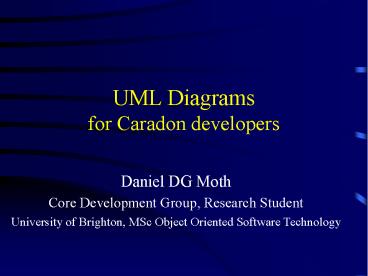UML Diagrams for Caradon developers - PowerPoint PPT Presentation
Title:
UML Diagrams for Caradon developers
Description:
UML Diagrams for Caradon developers Daniel DG Moth Core Development Group, Research Student University of Brighton, MSc Object Oriented Software Technology – PowerPoint PPT presentation
Number of Views:179
Avg rating:3.0/5.0
Title: UML Diagrams for Caradon developers
1
UML Diagramsfor Caradon developers
- Daniel DG Moth
- Core Development Group, Research Student
- University of Brighton, MSc Object Oriented
Software Technology
2
Use Case Diagram
- Captures system functionality as seen by users
- Built in early stages of development
- Purpose
- Specify the context of a system
- Capture the requirements of a system
- Validate a systems architecture
- Drive implementation and generate test cases
- Developed by analysts and domain experts
3
Use Case Diagram
4
Class Diagram
- Captures the vocabulary of a system
- Built and refined throughout development
- Purpose
- Name and model concepts in the system
- Specify collaborations
- Specify logical database schemas
- Developed by analysts, designers, and implementers
5
Class Diagram
6
Package Diagram
7
Object Diagram
- Shows instances and links
- Built during analysis and design
- Purpose
- Illustrate data/object structures
- Specify snapshots
- Developed by analysts, designers, and implementers
8
Object Diagram
9
Sequence Diagram
- Captures dynamic behavior (time-oriented)
- Purpose
- Model flow of control
- Illustrate typical scenarios
10
Sequence Diagram
11
Collaboration Diagram
- Captures dynamic behavior (message-oriented)
- Purpose
- Model flow of control
- Illustrate coordination of object structure and
control
12
Collaboration Diagram
13
State Diagram
- Captures dynamic behavior (event-oriented)
- Purpose
- Model object lifecycle
- Model reactive objects (user interfaces, devices,
etc.)
14
State Diagram
15
Component Diagram
- Captures the physical structure of the
implementation - Built as part of architectural specification
- Purpose
- Organize source code
- Construct an executable release
- Specify a physical database
- Developed by architects and programmers
16
Component Diagram
17
Deployment Diagram
- Captures the topology of a systems hardware
- Built as part of architectural specification
- Purpose
- Specify the distribution of components
- Identify performance bottlenecks
- Developed by architects, networking engineers,
and system engineers
18
Deployment Diagram
19
Deployment Diagram
20
Activity Diagram
- Captures dynamic behavior (activity-oriented)
- Purpose
- Model business workflows
- Model operations
21
Activity Diagram
22
More diagrams on the board
23
Reference
- The diagrams in this presentation were taken from
- The Unified Modeling Language Reference Manual
(Addison-Wesley Object Technology Series) by
James Rumbaugh, Ivar Jacobson, Grady Booch






























